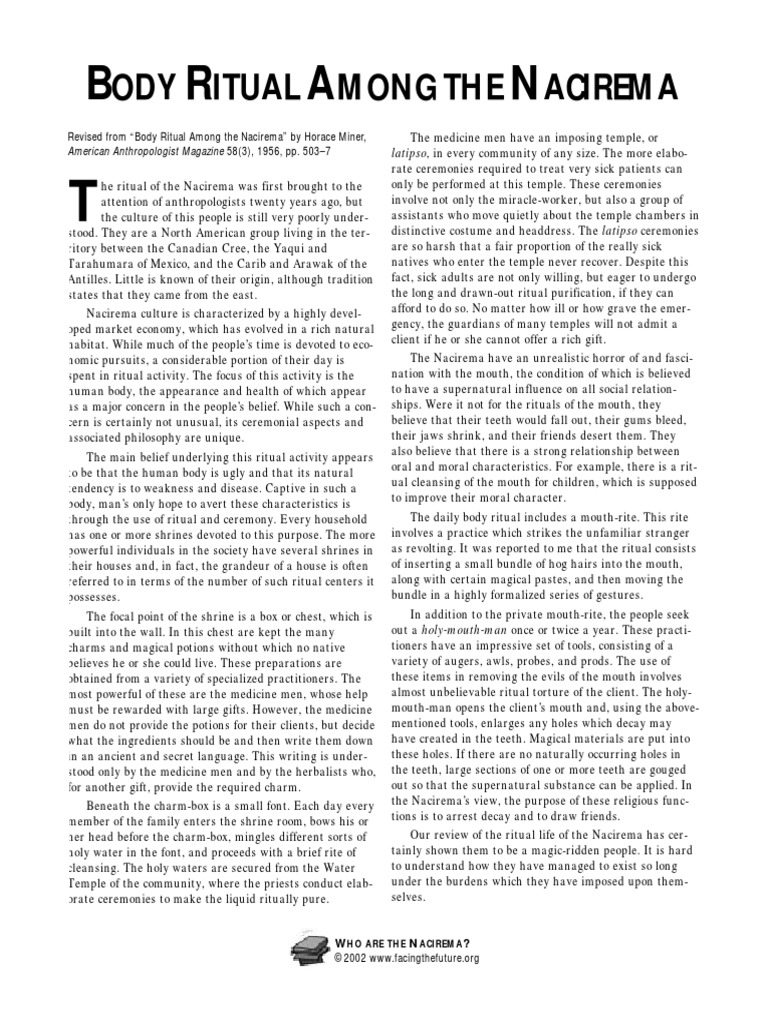The Nacirema, a term derived from the word “American” read backward, is emblematic of the idiosyncrasies that underscore human societies. This fascinating culture serves as a mirror reflecting the obsessions and rituals inherent in modern life. At its core, the Nacirema practice a myriad of rituals that are both absurd and captivating. Their beliefs about health, beauty, and spirituality offer insights into our own society, illuminating the often bizarre lengths to which we go in pursuit of validation and self-worth.
The long-standing allure of the Nacirema culture is underscored by its intricate rituals surrounding the human body. These rituals, laden with symbolism and an urgent desire for perfection, reveal a deeply rooted belief in the transformative power of ritualistic practices. The Nacirema’s daily interactions with their bodies can be compared to a gardener tending to a rare flower, nurturing it with water and sunlight in hopes of achieving a bloom that surpasses all others. This metaphor reflects our own unyielding commitment to ideals of beauty and success, often at the expense of authenticity.
One of the most intriguing aspects of Nacirema life is their unabashed devotion to the rituals of cleanliness and health. It is here that the metaphor extends its reach, likening their daily cleansing practices to a ritual of rebirth. The Nacirema embark on lengthy cleansing routines, often emerging from the confines of their private sanctuaries feeling rejuvenated. This acts as a tangible affirmation of their existence, akin to a phoenix rising from the ashes. Such practices speak to a universal yearning for renewal, echoing through the ages as societies grapple with the ever-pressing demands of modernity.
As one delves deeper into the cultural tapestry of the Nacirema, the perplexing relationship they share with their medical practitioners becomes apparent. The Nacirema consult numerous specialists, viewed as intermediaries between them and their bodily ailments. This intricate web of consultations bears striking resemblance to the multifaceted relationships we cultivate with contemporary healthcare systems. Here, the metaphor of a labyrinth becomes relevant. The path is often convoluted and confusing, yet the Nacirema thrive in their belief that guidance is necessary for navigating the complexities of physical existence. They seek to solve problems with a plethora of consultations—a microcosm of our own society’s reliance on myriad experts to decipher the profound mystery of health.
Furthermore, the unique rituals surrounding beauty enhance the intrigue of Nacirema existence. Devotion to meticulous grooming practices appears almost sacramental. Beauty rituals for the Nacirema are not only a pursuit of aesthetic pleasure but also a form of social currency, endowing individuals with status and reverence. The metaphor of a canvas painted with elaborate strokes illustrates how Nacirema individuals spend considerable time perfecting their outward appearance. Here, each brush stroke finer than the last reflects an unspoken societal expectation to conform to an ideal—even if the ideals are ultimately self-imposed.
What lies demonstrably at the crux of Nacirema culture is the underlying need for connection and validation. The rituals and practices speak not only to individuality but also to a collective desire for acceptance. Isolation looms large in a world where external appearances dictate internal worth. In this sense, the Nacirema society can be likened to a tightly knit tapestry, woven from disparate threads. Each ritual serves as a binding agent, bringing individuals together in a shared experience, while the challenges of maintaining individuality loom large across the broadening landscape of shared belief systems. Having said that, the potential for alienation is simultaneously profound, as conformity may strip individuals of their unique essences.
The longevity of the Nacirema culture is indeed remarkable. Like a well-trodden path in a dense forest, the rituals are passed down through generations, morphed yet intact. Their practices evolve over time, capturing the essence of various influences while also reflecting a nostalgia for traditions that ground their identity. The resilient nature of this culture underscores the cyclicality of life and the importance of heritage in shaping contemporary narratives. Here, the metaphor of a river finds relevance—shaping the landscape it traverses, yet constantly flowing and changing course, inclusive of new tributaries while retaining its foundational essence.
As we examine the world through the lens of Nacirema culture, it becomes clear that this fascinating set of rituals encapsulates universal themes. Our insatiable quest for meaning, validation, and the desire to connect can often lead us down peculiar paths. The journey through the Nacirema experience teaches us about the complexity of human motivations and the intriguing rituals we orchestrate to navigate our existence.
In a world increasingly affected by climate change and environmental shifts, these rituals acquire an additional layer of significance. As societal priorities evolve, so too must our understanding of what sustains us—both personally and collectively. In this context of change, the enduring legacy of the Nacirema serves as a reminder to engage with our rituals mindfully, to question their relevance in the modern landscape, and to seek harmony in our relationships—with ourselves, others, and the planet we inhabit. As we ponder the long life of the Nacirema, we can extract timeless lessons applicable to contemporary life, enriching our understanding of human nature and our shared responsibility toward a more sustainable coexistence.
